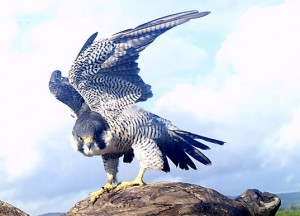Truly iconic

Iconic is a description that should be hard earned. Overused it loses significance but applying the word in the right place can raise the profile of an ailing species.
The tiger, polar bear and spoon-billed sandpiper are three species worthy of the term. The first two qualify because of their majesty and vulnerability. The bird is unique and has such a tenuous future that it could hardly be anything but iconic.
Equally deserving is the peregrine falcon, the world’s fastest-moving animal. Persecution, egg collecting and the effects of the pesticide DDT brought the species to its knees in the 1960s.
Prohibition of the chemical and increased vigilance around breeding sites has since helped UK numbers climb to 1,400 pairs although researchers last week suggested that persecution continues on north England grouse moors.
At WWT’s Slimbridge HQ the birds are thriving, however. One female has been particularly active over the Severn Estuary - a smörgåsbord for a hungry falcon. On Friday she was featured on BBC Autumnwatch.
Slimbridge warden James Lees has a camera trained on one of the bird’s favourite perches and has gathered some fantastic images.
In accompanying film clips he recounts her cunning as she waits for gulls to roost before mounting her evening raid. “I saw her stooping through the middle of them sending thousands of birds peeling around almost like a kind of vortex,” he says.
“It was an absolutely incredible sight.”
James adds: “Slimbridge is one of the top sites for peregrines in the whole country. You can pretty much guarantee a sighting if you come.”
The chances of seeing this truly iconic bird at Slimbridge (or other WWT centres including Martin Mere in Lancashire, Caerlaverock, Dumfriesshire and Arundel in West Sussex) can only increase as temperatures drop and waterbirds flock in.

